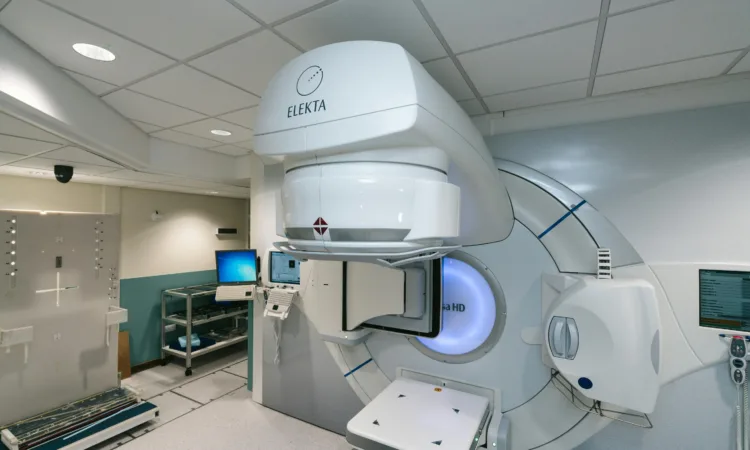
Introduction to SDN and AI in hospital cybersecurity

The healthcare industry is staggering under the onslaught. In 2023, ransomware attacks on hospitals increased by a whopping 94%, with an average cost of over $10 million per breach incurred due to downtime, fines, and reputational damages (Ponemon Institute).
As cybercriminals take advantage of antiquated systems and skewed IoT devices, hospitals have begun the adoption of smart technologies that promise to overhaul the existing paradigm of cybersecurity in the healthcare sector: namely software-defined networking (SDN) and Artificial Intelligence (AI). In concert, they are now protecting patient data and ensuring the availability of the life-supporting systems.
In this post we will discuss role of SDN and AI in hospital cybersecurity in 2025
The Growing Threat to Hospital Cybersecurity
A new study finds most hospitals are woefully unprepared when it comes to cyberattacks, and the impact on patient care can be substantial. Here’s what ABC’s Lionel Moise says:
It’s a growing problem for hospitals nationwide. Cyber attacks Experts say the number of attacks has doubled since 2016 and is driving up the cost of medical care for all of us. The University of Vermont Hospital Network knows the damage cybercriminals can do.
Our phones weren’t working. We actually sent some staff to Best Buy to buy walkie-talkies, and we started switching over to our paper systems, Doctor Stephen Leffler says. The crisis stretched for 28 days. 1300 hospital servers and 5000 computers had to be wiped. A job so big the governor called in the National Guard.
He says no patient data was leaked, but the impact on care was substantial.
We’ve had three years of COVID. This was much harder by a factor of 10. There were people that were scheduled for staging cancer operations, and we had to make a decision: should we do it? And we did them when it was appropriate. Some were able to delay. Experts say hospital networks are ripe targets because they’re often more vulnerable than other companies and because hospitals are more likely to pay a ransom.
In the Vermont case, the hospital. Ended up spending more than $50 million to resolve the attack. The cyberattack on a hospital is not an economic crisis. It is not a victimless crime. These are direct threats to patient safety and threats to life crimes.
A new government analysis finds. Nearly all hospitals, 96%, are operating with critical systems or software programs that have known vulnerabilities, but only 53% have a plan to address those vulnerabilities. Lionel Moyes, ABC News. New York. Experts are urging hospitals to beef up their cybersecurity and train staff on how to operate without computers, just in case.
Hospitals are prime targets for cyberattacks due to:
- Legacy systems: 60% of healthcare organizations still rely on outdated software like Windows 7.
- IoT vulnerabilities: A single MRI machine or insulin pump can become a gateway for hackers.
- Ransomware: Attacks like the 2023 Clop ransomware campaign disrupted patient care at 15+ hospitals.
- HIPAA compliance risks: Penalties for data breaches now exceed $2 million per violation.
Traditional firewalls and manual monitoring can’t keep pace. Enter SDN and AI—technologies designed for speed, scalability, and precision.
Also Read– Washington Ai security summit 2025- hottest topics Innovating Cyber Defense
Software-Defined Networking (SDN): Reinventing Hospital Networks
What is SDN?
SDN decouples a network’s control plane (decision-making) from its data plane (data routing). This allows centralized, programmable management of hospital networks—think of it as a “brain” directing traffic in real time.
Why Hospitals Need SDN
- Micro-Segmentation: Isolate MRI machines, EHR systems, and IoT devices into secure zones. If a ventilator gets infected, SDN walls off the threat instantly.
- Automated Compliance: Enforce HIPAA policies across devices. SDN auto-blocks unauthorized access to patient records.
- Legacy System Integration: SDN overlays modern security onto old infrastructure without costly upgrades.
- Zero Trust Architecture: Continuously validate user access, even for internal staff.
AI in Hospital Cybersecurity:

Need for AI in Cybersecurity
AI is essential in cyber security due to the rapidly evolving nature of cybersecurity threats, as it enhances the speed and accuracy of threat detection and automates real-time responses identifies patterns in data breaches, predicts vulnerabilities, and strengthens defense against emerging attack vectors, ultimately providing organizations with the edge needed to effectively safeguard digital assets and data in the modern threat landscape.
AI and machine learning (ML) are transforming threat detection from reactive to proactive.
- Anomaly Detection: AI learns “normal” network behavior. A sudden spike in data transfers from a CT scanner? Alert triggered.
- Predictive Analytics: ML models analyze historical attack patterns to predict and block zero-day exploits.
- Automated Response: AI quarantines suspicious devices, halting ransomware before it spreads.
- NLP-Powered Monitoring: AI scans emails and logs for phishing keywords (e.g., “urgent invoice”) with 95% accuracy.
Case Study: A Boston hospital reduced false positives by 70% using AI-driven monitoring, freeing IT teams to focus on critical tasks.
Also Read– Dark Realities of AI Porn: What You Should Be Aware Of 2025
SDN and AI in hospital cybersecurity

When combined, SDN and AI create an adaptive, self-defending network:
Real-Time Threat Mitigation
- AI detects an attack on a patient monitoring system.
- SDN reroutes traffic and isolates the device within milliseconds.
Scalability for IoT Growth
- AI manages security for 10,000+ connected devices (IV pumps, wearables).
- SDN dynamically allocates bandwidth to prioritize emergency room operations.
Cost Efficiency
- Automation slashes incident response costs by 40% (Accenture).
Real-World Success Stories
- Ransomware Neutralized: A Midwest hospital used SDN to segment its PACS imaging system during an attack, preventing data loss and keeping ER operations running.
- AI-Powered Defense: A European healthcare network cut breach detection time from 48 hours to 15 minutes using ML algorithms.
3. Northside Hospital uses Vectra AI to detect cyber attacks
Who is Northside Hospital?
The Northside Hospital is a five hospital, not-for-profit community-based Hospital. They have over 37,000 devices on any given day on wires somewhere. The ability to inspect traffic across the wire is very very limited.
The Hospital’s challenge and needs
Director of Information Security says “We looked around a lot and finally came to looking at Vectra Ai“.
“Cognito” does a very specific set of things, which were exactly the set of things we needed, and we didn’t see that level of fit for our specific area coming from anyone else. My team has been elbows deep inside of “Cognito” since day one. It’s becoming the first or second tool that they’re diving into to understand the full context of whatever it is they’re investigating. With our deployment of Vectra, we’ve been able to pull in data that otherwise would not have been available to us.
The benefits of Vectra’s cybersecurity solution
The “Cognito” platform allows you to discover everything on the side of the egress firewall. I think our engineers started using “Cognito” within 12 hours of it being turned on. No one else that we talked to could remotely approach the speed of deployment and the speed of getting actionable information from my network.
Vectra’s professionnal services and commitment
Veterans professional services have been the key force multiplier for how we got this done quickly and how we’ve gotten it done effectively. There was a lot of coaching and a lot of really positive relationships that were built between, you know, the veterans pro-serve team and my team, and it demonstrates a level of commitment to a customer that not every manufacturer does.
Challenges to Adoption
- Cost: Implementing SDN and AI requires upfront investment (though ROI is swift).
- Skill Gaps: 52% of hospitals lack in-house cybersecurity experts (HealthITSecurity).
- Data Privacy: Ensuring AI models comply with GDPR and HIPAA when processing patient data.
The Future of Hospital Cybersecurity
Every day, healthcare heroes push the boundaries of innovation, saving lives and advancing medical care, but beneath this progress, a silent threat looms.
Digital transformation has improved patient care, making treatment faster and more precise, but these advancements come with risks. Cybercriminals understand that in health care, every second matters.
Ransomware in breaches risks patient safety and erodes trust, with 2024 seeing daily breaches of 373,000. Proactive threat detection and zero-trust frameworks strengthen defenses with AI-driven monitoring and strict access controls.
Healthcare providers can safeguard their data and ensure patient safety with robust cybersecurity. health care providers can refocus on their true mission: caring for patients without fear of compromise at Progressive Infotech:
We are your trusted cybersecurity partner, ensuring healthcare systems remain secure, resilient, and focused on saving lives.
- Self-Healing Networks: AI will auto-patch vulnerabilities while SDN reroutes traffic.
- Blockchain Integration: Immutable ledgers to track access to sensitive records.
- 5G and Edge Computing: Ultra-fast networks enabling real-time AI analysis of surgical IoT devices.
FAQs
Q: Can SDN and AI replace firewalls?
No, SDN and AI cannot fully replace traditional firewalls—but they dramatically enhance their capabilities and fill critical gaps in modern healthcare cybersecurity. Here’s why the future lies in integration, not replacement, and how these technologies work together to protect hospitals.
Q: How does AI handle patient privacy?
Patient privacy is non-negotiable in healthcare, especially with regulations like HIPAA (U.S.) and GDPR (EU) imposing strict penalties for data breaches. AI systems in healthcare are designed to balance cutting-edge threat detection with ironclad privacy protections. Here’s how AI safeguards sensitive patient data while improving cybersecurity:
Q: Is SDN compatible with legacy systems?
Yes! SDN overlays work with existing hardware, making upgrades cost-effective.
Conclusion: A New Era of Cyber-Resilient Healthcare
The stakes have never been higher. A single breach can delay surgeries, leak sensitive records, or—worst of all—endanger lives. SDN and AI aren’t just tools; they’re lifelines for hospitals navigating the digital age. By embracing these technologies, healthcare providers can stay ahead of attackers, protect patients, and focus on what matters most: saving lives.
